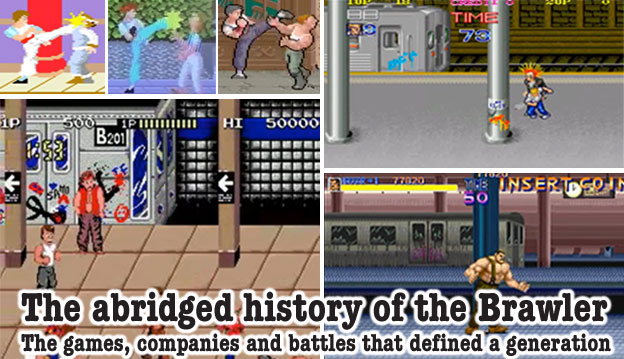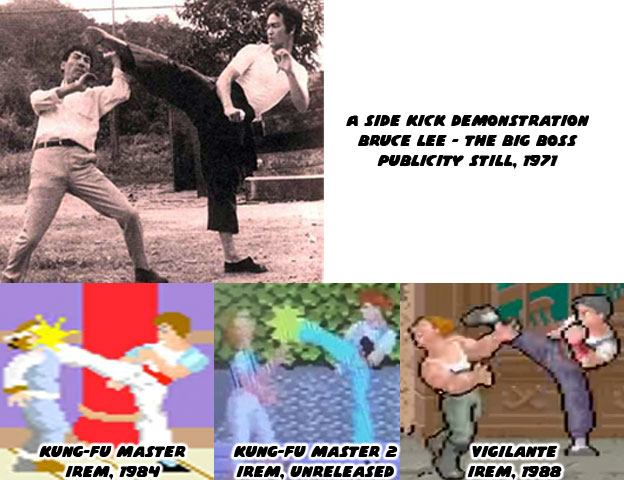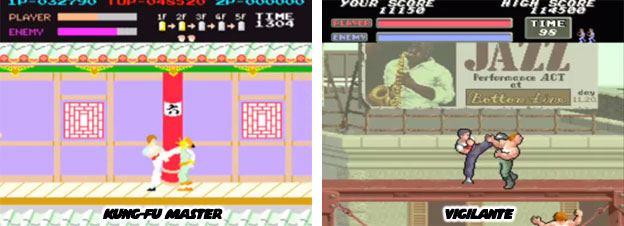
Today we'll look at the godfather of the brawling game. As fellow 1UP member Jgusw pointed out it might have been Renegade. It was a game released by Taito in 1986, exactly one year before the same studio released Double Dragon. This was actually the western version of the game called Nekketsu Kouha Kuniou-Kun which translated to "Hot Blood Tough Guy Kunio." It was developed by Technos and the main character was named after Technos president Kunio Taki. The game about high school tough guys and gang members doing battle.
The game looked and played a little "looser" than Double Dragon but all of the familiar elements were there. Players were constantly hounded by gang members and could use anything available to defend themselves. As with Double Dragon players could use weapons and even the environment to their advantage. The animation, and visual style of the game was the template that Double Dragon followed and refined. If Renegade had one failing it was the brevity of the game. The three levels and bosses can be defeated in under six minutes. Double Dragon provided a more robust experience and lasted about five time longer. That was probably why more gamers remembered this title.
As fun as Renegade was, it too was not the founder of the brawling experience. In 1984, the same year that Karate Champ debuted, Irem had released Kung-Fu Master. The brawling game and fighting game were canonized at the same time. Kung-Fu Master featured a familiar story, a gang kidnapped Silvia, the love interest of Thomas the kung-fu master. I found it odd that neither of them had traditional Chinese names… Thomas had to fight wave after wave of opponents to reach his beloved. The character used nothing more than his quick hands and feet to defeat different character types including knife throwers, burly guards, dragons and even little people.

Thomas was the first character that was closely modeled after Bruce Lee. While his costume might not bring up memories of the actor, his moves and trademark yell certainly should. Lee was a perfect template to build martial artists from. His punches and kicks worked well when illustrated. He had a dynamic range, his moves were easy to read when created frame by frame. Best of all he was recognized the world over as a martial artist that really moved as fast as any game character could.
This game established the formula of waves of opponents approaching from the left and right, different strengths and weaknesses for those opponents and also boss fights. The idea of fighting combinations exploited in Renegade and Double Dragon was not quite the same. Players could switch between punches and kicks but the game system did not include knees, elbows or headbutt attacks at different ranges. The speed and damage that diverse strikes provided made the latter games more efficient when dealing with scores of rivals. By comparison Kung-Fu Master was more about finding the right timing against the advancing hordes and pressing the attack buttons quickly.

The seeds for the brawler were germinating and bearing fruit. Irem had actually planned a sequel to Kung-Fu Master. They had created a prototype board featuring new sprites, animations and villains but with the same familiar Chinese location. The publisher was afraid that this game wouldn't be interesting to Western audiences because it was more of the same. So they cancelled production on the game and went back to the drawing board. A year after Double Dragon was released Irem returned with what many consider to be the spiritual successor to Kung-Fu Master. Vigilante, published by Data East in 1988, improved on the mechanics in every way and brought the martial arts legend to the modern world. Ancient China was traded out for the urban jungle which looked an awful lot like New York City. The girlfriend was named Madonna and the unnamed hero, possibly the reincarnation of Thomas could get access to a weapon, a nunchaku to help out against the Skinheads terrorizing the city. A great deal of the mechanics from Kung-Fu Hero were preserved with different-sized opponents sneaking up on the hero from both sides. The visuals and animations were updated thanks to the newer hardware and software.
The format of keeping all of the action to a 2D plane seemed limiting to gamers. That mechanic went over well with the original arcade brawler but seemed dated now that engines could have characters move all over the screen in a pseudo-3D environment. A few other great games would preserve the 2D legacy and they will be mentioned in due time but for the majority of gamers the brawler held more potential when the world opened up and the brawling required more strategy. 1988 saw several other games looking to give Double Dragon a run for the title. We shall look at these in the next blog. As always if you enjoyed this blog and would like to sponsor me please visit my Patreon page and consider donating each month, even as little as $1 would help make better blogs and even podcasts!

Hard to say, but I believe Irem made the right decision with kung fu Master 2.
ReplyDelete